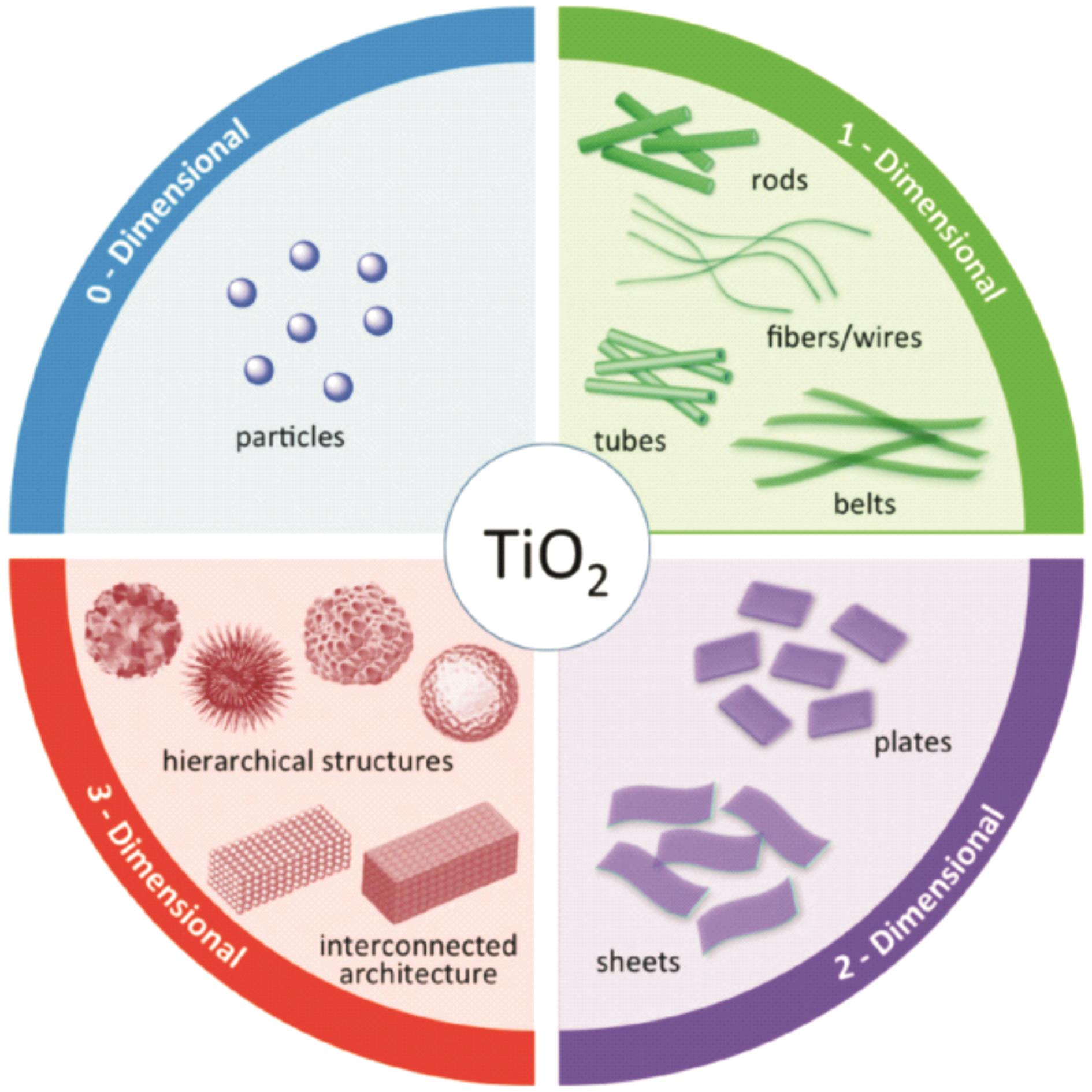
应用化学 ›› 2022, Vol. 39 ›› Issue (4): 629-646.DOI: 10.19894/j.issn.1000-0518.210483
纳米TiO2光催化抗菌应用的研究进展
- 1.吉林大学电子科学与工程学院,集成光电子学国家重点实验室,长春 130012
2.吉林大学口腔医院种植科,长春 130021
-
收稿日期:2021-09-28接受日期:2022-02-21出版日期:2022-04-01发布日期:2022-04-19 -
通讯作者:王林,董彪 -
作者简介:E⁃mail: wanglin1982@jlu.edu.cn
E⁃mail: dongb@jlu.edu.cn;
-
基金资助:国家自然科学基金(61775080);山东省自然基金(ZR2020ZD36)
Research Progress on Photocatalytic Antibacterial Application of TiO2 Nano Materials
Jia-He WANG1, Da-Yong LIU1, Wei LIU1, Lin WANG2( ), Biao DONG1(
), Biao DONG1( )
)
- 1.College of Electronic Science and Engineering,Jilin University,State Key Laboratory of Integrated Optoelectronics,Changchun 130012,China
2.Hospital of Stomatology,Jilin University,Dental Implantation,Changchun 130021,China
-
Received:2021-09-28Accepted:2022-02-21Published:2022-04-01Online:2022-04-19 -
Contact:Lin WANG,Biao DONG -
Supported by:the National Natural Science Foundation of China(61775080);the Major Basic Research Projects of Shandong Natural Science Foundation(ZR2020ZD36)
摘要:
光催化纳米TiO2以其出色的光催化、化学稳定性以及广谱抗菌性受到科研人员的青睐。然而,其存在的一些问题,如宽带隙、高过电位和光生载流子快速复合等限制了其光催化性能。本文综述了近年来TiO2光催化在抗菌方面的研究进展。对纳米TiO2光催化抗菌作用机理进行了探讨,并讨论了提高TiO2光催化抗菌活性的几种策略,包括进行纳米TiO2结构设计、光的调控、掺杂金属离子、掺杂非金属离子、贵金属修饰和偶联其他材料。 改性TiO2光催化剂显著抑制了细菌细胞的生长,在生物医学工程领域具有独特的应用前景。
中图分类号:
引用本文
王佳赫, 刘大勇, 刘伟, 王林, 董彪. 纳米TiO2光催化抗菌应用的研究进展[J]. 应用化学, 2022, 39(4): 629-646.
Jia-He WANG, Da-Yong LIU, Wei LIU, Lin WANG, Biao DONG. Research Progress on Photocatalytic Antibacterial Application of TiO2 Nano Materials[J]. Chinese Journal of Applied Chemistry, 2022, 39(4): 629-646.
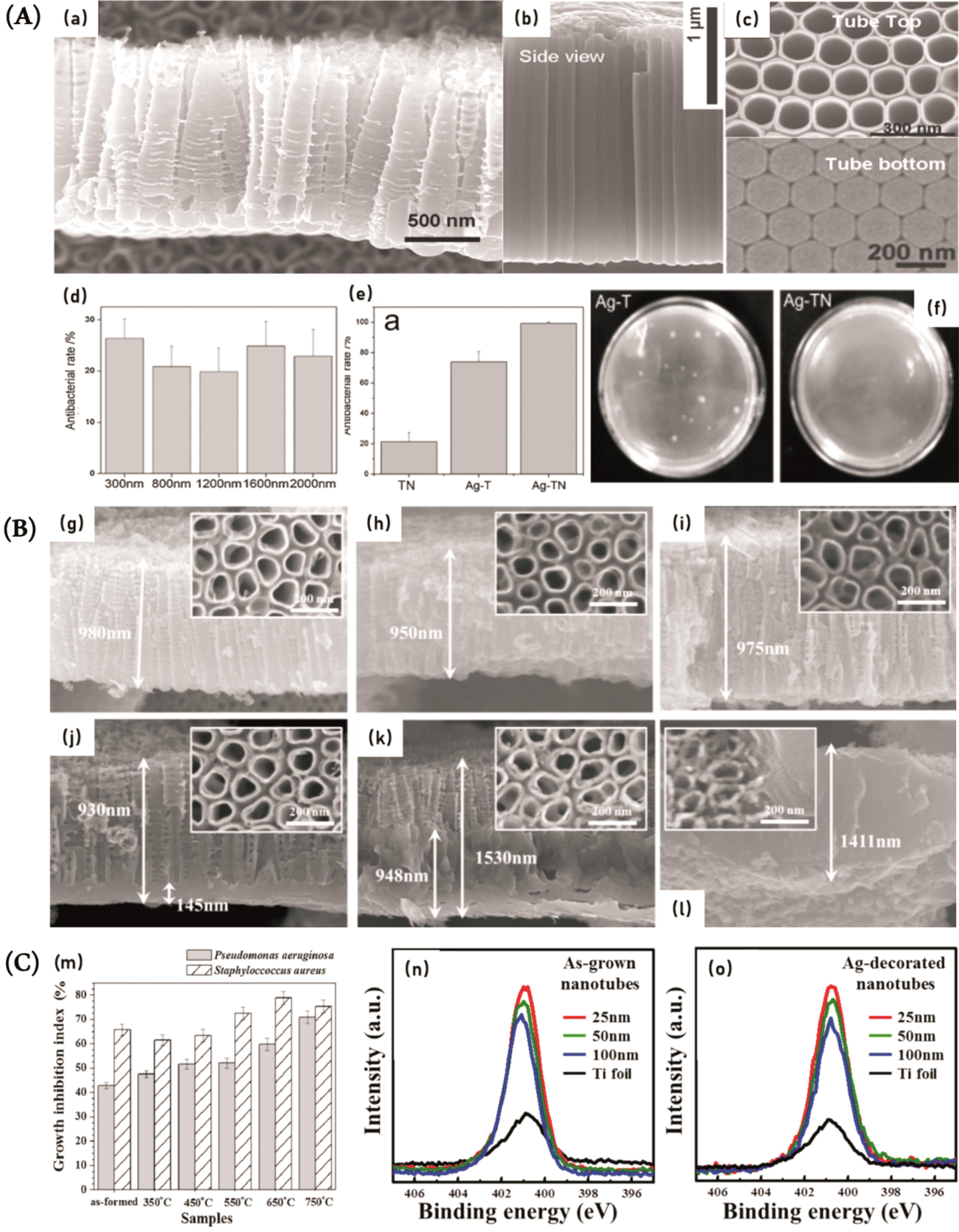
图3 (A)TiO2一维纳米管抗菌实验结果图像(a-c)扫描电镜图像: (a)第1代TiO2纳米管层(短和侧壁波纹); (b)最新一代TiO2纳米管层(高宽比,高度有序,光滑的壁)显示侧视图(c)顶部和底部视图(面板b和c)[6];(d-f)图d[7]为不同长度和直径为 100 nm 的钛纳米管的抗菌率,图e、f为不同材料抗菌率:Ag-T,银沉积平钛板:Ag-TN,银沉积的钛纳米管,直径100 nm,长度800 nm; (B) TiO?2的横截面和顶部视图(插图)SEM 图像??纳米管:(g)无定形和在温度下退火, (h) 350 ℃, (i) 450 ℃, (j) 550 ℃, (k) 650 ℃, (l) 750 ℃[8]; (C)(m)?TiO?2的抗菌活性??纳米管:铜绿假单胞菌??和??金黄色??葡萄球菌的生长抑制指数[8]; (n-o)N1s生长和银装饰TiO?2纳米管XPS结果[9]
Fig.3 (A) Image of TiO2 one-dimensional nanotube antibacterial experiment results (a-c) SEM images of (a) first-generation titanium dioxide nanotube layer (short and side wall ripple) and (b)the latest generation of titanium dioxide nanotube layers (height to width ratio, highly ordered, smooth walls) show side view (c)top and bottom views (Panels b and c)[6]; (d-f) Figure d[7] shows the antibacterial rate of titanium nanotubes with different lengths and diameters of 100 nm, while Figure e and f show the antibacterial rate of different materials: Ag-T, Silver deposited flat titanium plate; Ag-TN, silver deposited titanium nanotubes, diameter 100 nm, length 800 nm; (B) (g-l) TiO2 cross section and top view (inset) SEM image of the astrologer nanotube: (g)Amorphous and degenerates at temperature: (h)350 ℃: (i)450 ℃: (j)550 ℃: (k)650 ℃: (l)750 ℃[8]; (C) (m)The growth inhibition indices of Pseudomonas aeruginosa and Staphylococcus aureus[8]; (n-o) XPS surface analysis results of N1s growth in the spectrum and silver decorated TiO2 nanotubes[9]
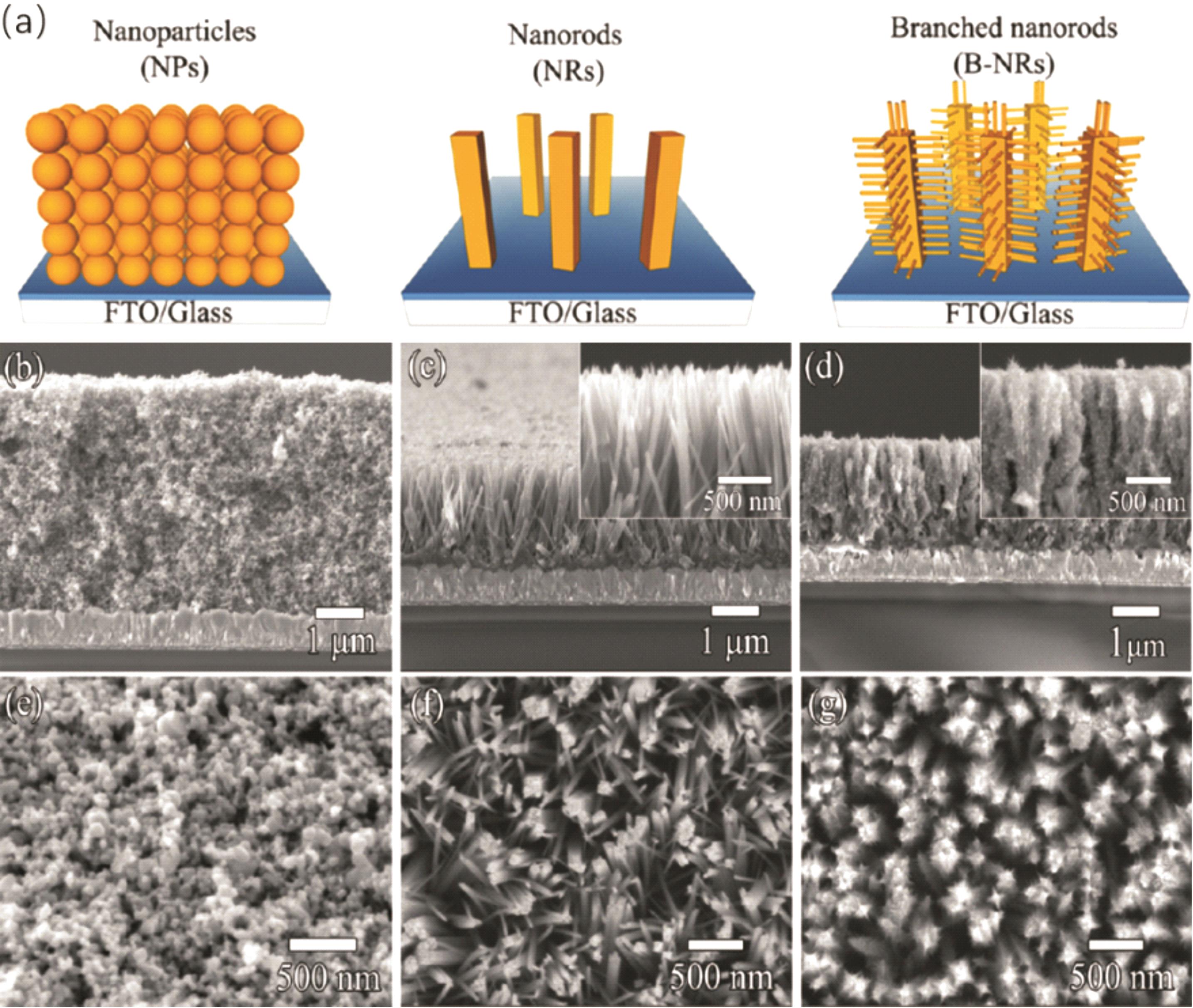
图4 (a) NPs、NRs、B-NRs概要描述示意图; (b,e)纳米粒子(NPs)SEM图像; (c,f)纳米棒(NRs)SEM图像; (d,g)单晶支链纳米棒(B-NRs)SEM图像[19]
Fig.4 (a) NPs, NRs, B-NRS schematic description. (b, e) SEM image of nano-particles (NPs). (c, f) SEM image of nanorods (NRs). (d, g) SEM image of single crystal branched nanorods (B-NRS) [19]

图5 TiO2的核壳结构(a-p)各种TiO2基核壳纳米光催化剂的TEM图像。(a)核壳结构、(b)空心结构、(c,d)蛋黄壳结构、(e,f)双壳结构。各种形状的核也被使用,(g,h)纳米粒子,(i-l)纳米棒、(m)纳米立方体、(n)更复杂的核壳结构、(o,p)没有内腔的多壳结构[27];(q-s)不同光照条件下样品的抗菌活性: (q) c-Fe2O3@SiO2@TiO2-Ag, (r) TiO2和(s)对照(无催化剂)[28]; (t-u)在原始TiO2和TiO2/聚[2-(叔丁基氨基)甲基丙烯酸乙酯-共聚乙二醇二甲基丙烯酸酯]核/壳纳米粒子表面对(t)大肠杆菌和(u)金黄色葡萄球菌的存活率与紫外线照射时间(min)的关系图[29]
Fig.5 Core-shell structure of TiO2 (a-p) TEM images of various TiO2-based core-shell nanocatalysts. (a) Core-shell structure; (b) Hollow structure; (c,d) Yolk shell structure; (e,f) Double hull structure. Nuclei of various shapes were also used, (g,h) nanoparticles; (i-l) nanorods; (m) nanocube; (n) More complex core-shell structures; (o,p) A multishell structure without an inner cavity[27]; (q-s) Antibacterial activity of samples under different light conditions: (q) c-Fe2O3@SiO2 @TiO2-Ag (r)TiO2 is contrasted (s) (Without catalyst)[28]; (t-u) The survival rate of (t) Escherichia coli and (u) Staphylococcus aureus on the surface of raw TiO2 and TiO2/poly[2-(tert-butylamino) ethyl methacrylate-copolymer ethylene glycol dimethacrylate] core/shell nanoparticles in relation to UV irradiation time (min)[29]
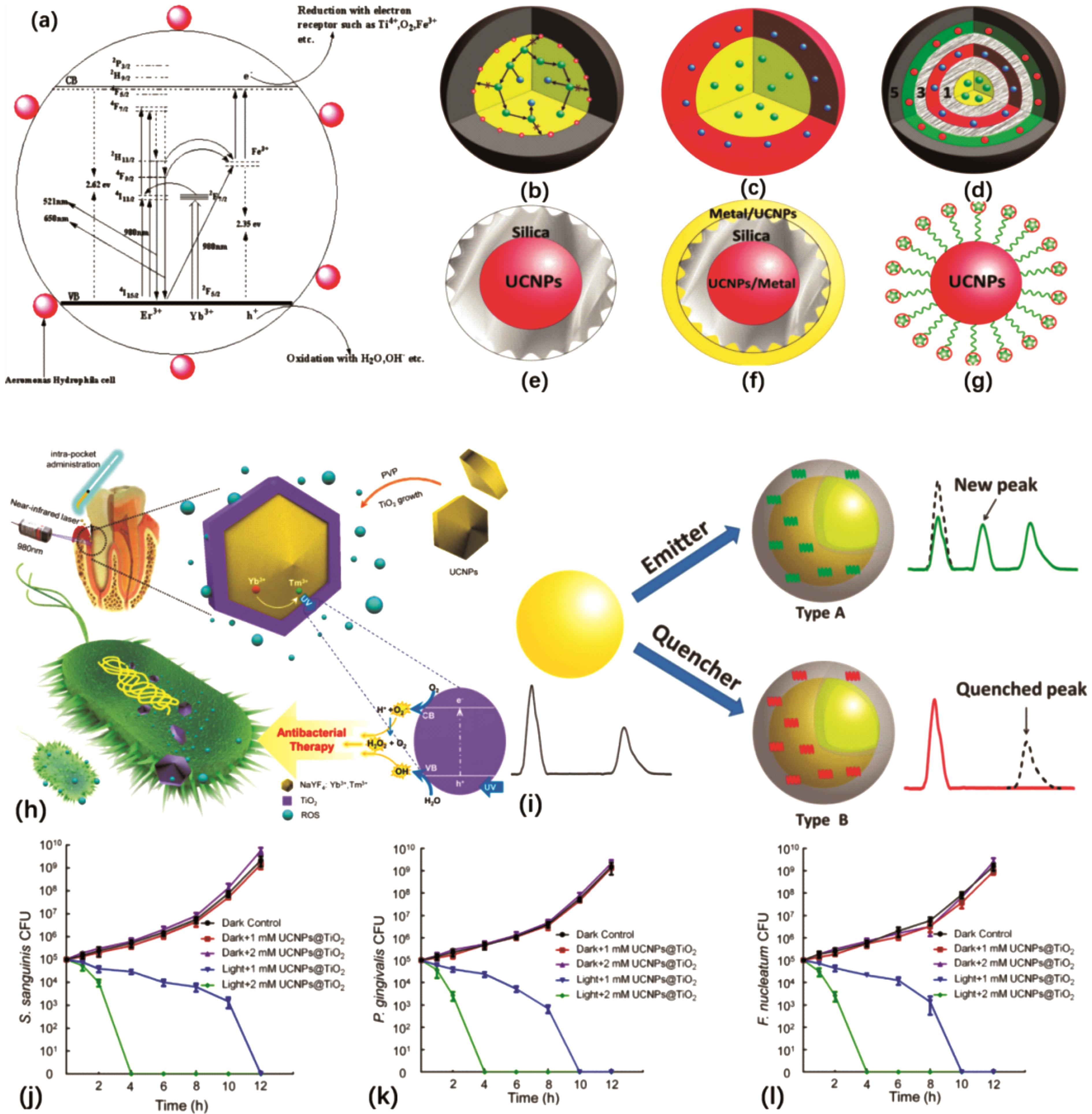
图6 (a)上转换能量转移机制[44]; (b-g)不同类型的核壳结构; (b)具有“惰性”(即没有任何吸收/发射镧系掺杂)壳层的核壳UCNPs; 核心区的彩色球描绘了镧系掺杂剂; 界面上的红色圆圈代表表面淬火部位;黑色箭头表示随机的能量传递路径; (c)具有活性壳层的核壳层UCNPs; (d)具有多个壳层的核壳UCNPs; (e) UCNPs@SiO2核壳纳米粒子; (f) 核心-壳-UCNPs@SiO2[48]; (h)NaYF4∶Yb3+,Tm3+@TiO2的合成及aPDT近红外辐射机理[47]; (i)使用非外延UCNPs二氧化硅核-壳结构-调谐上转换发光的示意图; (j-l) UCNPs@TiO2近红外辐射下对牙龈卟啉单胞菌和核纤层杆菌的时间杀伤试验结果[47]
Fig.6 (a) Upconversion energy transfer mechanism[44]; (b-g) Different types of core-shell structures. (b) Core-shell UCNPs with “inert” (i.e., without any absorbing/emitting lanthanide doping) shells; The color spheres in the core region depict lanthanide dopants; The red circle on the interface represents the surface hardening part; Black arrows represent random energy transfer paths; (c) Core-shell UCNPs with active shells; (d) Core-shell UCNPs with multiple shells; (e) UCNPs@SiO2 core-shell nanoparticles; (f) Core-shell UCNPs@SiO2[48]; (h)Synthesis of NaYF4∶ Yb3+,Tm3+@TiO2 and the mechanism of aPDT NEAR infrared Radiation Under the near infrared radiation[47]. (i) schematic of upconversion luminescence tuned using a non-epitaxy UCNPs silica core-shell structure; (j-l) Time killing test of porphyromonasgingivalis and Layer fibriumnucleobacillus under UCNPs@TiO2 near infrared radiation[47]

图7 (a)RhB在不同浓度Fe3+中的光催化降解比曲线?TiO2光催产物[57]; (b)不同浓度Fe 掺杂下TiO2对大肠杆菌抗菌率(■)裸露 TiO2的抗菌率,(●)0.1%、(▲)0.5%、(▼) 1.0%、(?) 2.0%、和(?) 3.45% 的 Fe 掺杂 TiO2对大肠杆菌??抗菌率[58]; (c)在700 ℃的水热条件下,在 9 h内合成了CeO2掺杂TiO2纳米复合材料的光催化研究[51]
Fig.7 (a) Curves of photocatalytic degradation ratio of RhB in Different concentrations of Fe3+[57]; (b) Antibacterial effect of TiO2 doped with Fe on Escherichia coli (■) Antifungal rate of bare TiO2, (●) 0.1%, (▲) 0.5%, (▼) 1.0%, (?) 2.0% and (?) 3.45% Fe doped TiO2 antifungal rate of Escherichia coli[58]. (c) The photocatalysis of CeO2 doped TiO2 nanocomposites was studied under hydrothermal condition of 700 ℃ in 9 h[51]

图8 (a)Ag NPs抗菌作用机制研究; (b)紫外-可见光下Au NPs对TiO2光催化活性的促进作用示意图; (c)大肠杆菌??的CFU在介质中不同时期培养a-TiO2、 Ag/a-TiO2和Ag-TiO2/Ag/a-TiO2?空白(控制)样相比,光催化??薄膜??在暗光(■)和可见光(▲)和太阳光(●)的照射下[59]; (d)海藻酸盐溶液与Au-TiO2纳米复合材料的降解曲线[63]
Fig.8 (a) Study on antibacterial mechanism of Ag NPs; (b) Schematic diagram of Au NPs promoting TiO2 photocatalytic activity in UV-visible light; (c) E.coli's CFU grows, at different times, in media, with the presence of low-light (■) and visible light (▲) and sunlight (●), as compared with a-TiO2, Ag/a-TiO2, Ag-TiO2/Ag/a-TiO2 and a-TiO2 blank (controlled) samples[59]; (d) Degradation curves of alginate solution and Au-TiO2 nanocomposites[63]
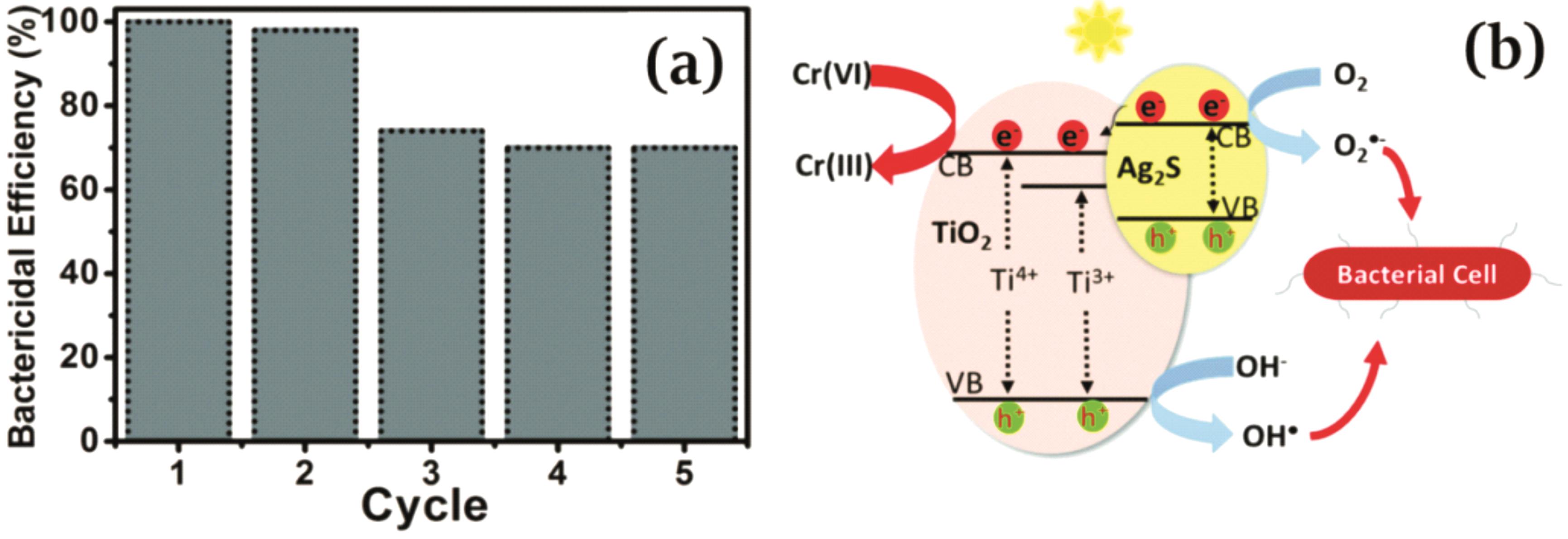
图9 (a)Ag2S/TiO2对??大肠杆菌??的杀菌效率; (b)Ag2S/TiO2 NFs消毒机制的示意图[90]
Fig.9 (a) The germicidal efficiency of Ag2S/TiO2 for the lost-Escherichiacoli; (b) Schematic diagram of Ag2S/TiO2 NFs disinfection mechanism[90]
| 1 | YAMAWUCHI K, YAO Y, OCHIAI T, et al. Antibacterial activity of hydrophobic composite materials containing a visible-light-sensitive photocatalyst[J]. J Nanotechnol, 2016, 33(7): 1989-1998. |
| 2 | MATSUNAGA T, TOMODA R, NAKAJIMA T, et al. Photoelectrochemical sterilization of microbial cells by semiconductor powders[J]. FEMS Microbiol Lett, 1985, 29(1/2): 211-214. |
| 3 | GOGNIAT G, THYSSEN M, DENIS M, et al. The bactericidal effect of TiO2 photocatalysis involves adsorption onto catalyst and the loss of membrane integrity[J]. FEMS Microbiol Lett, 2006, 258(1): 18-24. |
| 4 | OGUMA, KATAYAMA K, OHGAKI S. Photoreactivation of Escherichia coli after low-or medium-pressure UV disinfection determined by an endonuclease sensitive site assay[J]. Appl Environ Microbiol, 2002, 68(12): 6029-6035. |
| 5 | IIJIMA S. Helical microtubules of graphitic carbon[J]. Nature, 1991, 354(6348): 56-58. |
| 6 | PARAMASIVAM I, JHA H, LIU N, et al. A review of photocatalysis using self-organized TiO2 nanotubes and other ordered oxide nanostructures[J]. Small, 2012, 8(20): 3073-3103. |
| 7 | LI H, CUI Q, FENG B, et al. Antibacterial activity of TiO2 nanotubes: influence of crystal phase, morphology and Ag deposition[J]. Appl Surf Sci, 2013, 284(1): 179-183. |
| 8 | MAZARE A, TOBEA G, BURNEI C, et al. Corrosion, antibacterial activity and haemocompatibility of TiO2 nanotubes as a function of their annealing temperature[J]. Corros Sci, 2016, 103: 215-222. |
| 9 | LAN M Y, LIU C, HUANG H, et al. Both enhanced biocompatibility and antibacterial activity in Ag-decorated TiO2 nanotubes[J]. PLoS One, 2013, 8(10): e75364. |
| 10 | HOYER P. Formation of a titanium dioxide nanotube array[J]. Langmuir, 1996, 12(6): 1411-1413. |
| 11 | GUIN D, SUNKARA M, SINGH S, et al. Photoreduction of silver on bare and colloidal TiO2 nanoparticles/nanotubes: synthesis, characterization, and tested for antibacterial outcome[J]. J Phys Chem C, 2007, 111(36): 13393-13397. |
| 12 | YAN Y, ZHANG X, DING Q, et al. Antibacterial and bioactivity of silver substituted hydroxyapatite/TiO2 nanotube composite coatings on titanium[J]. Appl Surf Sci, 2014, 314(30): 348-357. |
| 13 | ZHANG H, SUN Y, TIAN A, et al. Improved antibacterial activity and biocompatibility on vancomycin-loaded TiO2 nanotubes: in vivo and in vitro studies[J]. Int J Nanomed, 2013, 8: 4379-4389. |
| 14 | VIET P, PHAN B, MOTT D, et al. Silver nanoparticle loaded TiO2 nanotubes with high photocatalytic and antibacterial activity synthesized by photoreduction method[J]. J Photochem Photobiol A, 2018, 352: 106-112. |
| 15 | XU W, QI M, LI X, et al. TiO2 nanotubes modified with Au nanoparticles for visible-light enhanced antibacterial and anti-inflammatory capabilities[J]. J Electroanal Chem, 2019, 842: 66-73. |
| 16 | BILEK O, FOHLEROVA Z, HUBALEK J. Enhanced antibacterial and anticancer properties of Se-NPs decorated TiO2 nanotube film[J]. PLoS One, 2019, 14(3): 1-15. |
| 17 | ZHANG X, HUANG Y, WANG B, et al. A functionalized Sm/Sr doped TiO2 nanotube array on titanium implant enables exceptional bone-implant integration and also self-antibacterial activity[J]. Ceram Int, 2020, 46(10): 14796-14807. |
| 18 | WANG X, LINA M, JIN M, et al. Composite coating of graphene oxide/TiO2 nanotubes/HHC-36 antibacterial peptide construction and an exploration of its bacteriostat and osteogenesis effects[J]. J Biomed Nanotechnol, 2021, 17(4): 662-676. |
| 19 | CHO I, CHEN Z, FORMAN J, et al. Branched TiO2 nanorods for photoelectrochemical hydrogen production[J]. Nano Lett, 2011, 11(11): 4978-4984. |
| 20 | LIU B, AYDIL E S. Growth of oriented single-crystalline rutile TiO2 nanorods on transparent conducting substrates for dye-sensitized solar cells[J]. J Am Chem Soc, 2009, 131(11): 3985-3990. |
| 21 | JOO J, SOON G, TAEKYUNG Y, et al. Large-scale synthesis of TiO2 nanorods via nonhydrolytic sol-gel ester elimination reaction and their application to photocatalytic inactivation of E. coli[J]. J Phys Chem B, 2005, 109(32): 15297-15302. |
| 22 | HASSAN M, AMNA T, MISHRA A, et al. Fabrication, characterization and antibacterial effect of novel electrospun TiO2 nanorods on a panel of pathogenic bacteria[J]. J Biomed Nanotechnol, 2012, 8(3): 394-404. |
| 23 | LIN Z, ROY P, SHIH Z, et al. Synthesis of anatase Se/Te-TiO2 nanorods with dominant {100} facets: photocatalytic and antibacterial activity induced by visible light[J]. Chempluschem, 2013, 78(4): 302-309. |
| 24 | KIM S, DHANDOLE L, SEO Y, et al. Active composite photocatalyst synthesized from inactive Rh & Sb doped TiO2 nanorods: enhanced degradation of organic pollutants & antibacterial activity under visible light irradiation[J]. Appl Catal A, 2018, 564: 43-55. |
| 25 | RILDA Y, DAMARA D, PUTRI Y, et al. Pseudomonas aeruginosa antibacterial textile cotton fiber construction based on ZnO-TiO2 nanorods template[J]. Heliyon, 2020, 6(4): e03710. |
| 26 | QIN Y, GUO Y, LIANG Z, et al. Au nanorods decorated TiO2 nanobelts with enhanced full solar spectrum photocatalytic antibacterial activity and the sterilization file cabinet application[J]. Chin Chem Lett, 2021, 32(4): 1523-1526. |
| 27 | GAO M, ZHU L, WEI L, et al. Structural design of TiO2-based photocatalyst for H2 production and degradation applications[J]. Catal Sci Technol, 2015, 5(10): 4703-4726. |
| 28 | CUI B, PENG H, XIA H, et al. Magnetically recoverable core-shell nanocomposites γ-Fe2O3@SiO2@TiO2-Ag with enhanced photocatalytic activity and antibacterial activity[J]. Sep Purif Technol, 2013, 103(15): 251-257. |
| 29 | KONG H, SONG J, JANG J. Photocatalytic antibacterial capabilities of TiO2-biocidal polymer nanocomposites synthesized by a surface-initiated photopolymerization[J]. Environ Sci Technol, 2010, 44(14): 5672-5676. |
| 30 | DHANALEKSHMI K, MEENA K. Comparison of antibacterial activities of Ag@TiO2 and Ag@SiO2 core-shell nanoparticles[J]. Spectrochim Acta A, 2014, 128: 887-890. |
| 31 | SALEHI M, ESHAGHI A, TAJIZADEGAN H. Synthesis and characterization of TiO2/ZnCr2O4 core-shell structure and its photocatalytic and antibacterial activity[J]. J Alloys Compd, 2019, 778: 148-155. |
| 32 | TAN S, CHEN J, LIU Y, et al. Preparation and properties of antibacterial TiO2@C/Ag core-shell composite[J]. Sci Technol Adv Mater, 2009, 10(4): 045002. |
| 33 | KELNER A. Photoreactivation of ultraviolet-irradiated escherichia coli, with special reference to the dose-reduction principle and to ultraviolet-induced mutation[J]. J Bacteriol, 1949, 58(4): 511-522. |
| 34 | ETACHERI V, MICHLITS G, SEERY M, et al. A highly efficient TiO2-xCx nano-heterojunction photocatalyst for visible light induced antibacterial applications[J]. Acs Appl Mater Interfaces, 2013, 5(5): 1663-1672. |
| 35 | AKHAVAN O, AZIMIRAD R, SAFA S, et al. Visible light photo-induced antibacterial activity of CNT-doped TiO2 thin films with various CNT contents[J]. J Mater Chem, 2010, 20(35):7386-7392. |
| 36 | GAO P, LIU J, ZHANG T, et al. Hierarchical TiO2/CdS “spindle-like” composite with high photodegradation and antibacterial capability under visible light irradiation[J]. J Hazard Mater, 2012, 229(30): 209-216. |
| 37 | ALI T, AHMED A, ALAM U, et al. Enhanced photocatalytic and antibacterial activities of Ag-doped TiO2 nanoparticles under visible light[J]. Mater Chem Phys, 2018, 212: 325-335. |
| 38 | ASHKARRAN A, HAMIDINEZHAD H, HADDAADI H, et al. Double-doped TiO2 nanoparticles as an efficient visible-light-active photocatalyst and antibacterial agent under solar simulated light[J]. Appl Surf Sci, 2014, 301: 338-345. |
| 39 | CAO B, CAO S, DONG P, et al. High antibacterial activity of ultrafine TiO2/graphene sheets nanocomposites under visible light irradiation[J]. Mater Lett, 2013, 93: 349-352. |
| 40 | VIGNESH S, SUGANTHI S, KALYANA J, et al. Fabrication of heterostructured vanadium modified g-C3N4/TiO2 hybrid photocatalyst for improved photocatalytic performance under visible light exposure and antibacterial activities[J]. J Ind Eng Chem, 2019, 76: 318-332. |
| 41 | ABEL K, BOYER J, ANDREI C, et al. Analysis of the shell thickness distribution on NaYF4/NaGdF4 core/shell nanocrystals by EELS and EDS[J]. J Phys Chem Lett, 2011, 2(3): 185-189. |
| 42 | BOGDAN N, VETRONE F, OZIN G, et al. Synthesis of ligand-free colloidally stable water dispersible brightly luminescent lanthanide-doped upconverting nanoparticles[J]. Nano Lett, 2011, 11(2): 835-840. |
| 43 | BOYER J, GAGNON J, CAPOBIANCO J. Synthesis, characterization, and spectroscopy of NaGdF4∶Ce3+,Tb3+/NaYF4 core/shell nanoparticles[J]. Chem Mater, 2007, 19(14): 3358-3360. |
| 44 | WANG W, SHANG Q, ZHENG W, et al. A novel near-infrared antibacterial material depending on the upconverting property of Er3+-Yb3+-Fe3+ tridoped TiO2 nanopowder[J]. J Phys Chem C, 2010, 114(32): 13663-13669. |
| 45 | CHEN Y, MISHRA S, LEDOUX D, et al. Direct synthesis of hexagonal NaGdF4 nanocrystals from a single-source precursor: upconverting NaGdF4∶Yb3+,Tm3+ and its composites with TiO2 for near-IR-driven photocatalysis[J]. Chem Asian J, 2014, 9(9): 2415-2421. |
| 46 | YIN M, JU E, CHEN Z, et al. Upconverting nanoparticles with a mesoporous TiO2 shell for near-infrared-triggered drug delivery and synergistic targeted cancer therapy[J]. Chem Eur J, 2014, 20(43): 14012-14017. |
| 47 | QI M, LI X, SUN X, et al. Novel nanotechnology and near-infrared photodynamic therapy to kill periodontitis-related biofilm pathogens and protect the periodontium[J]. Dent Mater, 2019, 35(11): 1665-1681. |
| 48 | CHEN G, AGREN H, TYMISH Y, et al. Light upconverting core-shell nanostructures: nanophotonic control for emerging applications[J]. Chem Soc Rev, 2015, 44(6): 1680-1713. |
| 49 | YI G, PENG Y, GAO Z. Strong red-emitting near-infrared-to-visible upconversion fluorescent nanoparticles[J]. Chem Mater, 2011, 23(11):2729-2734. |
| 50 | TRAPALIS C, KEIVANIDIS P, KORDAS G, et al. TiO2 (Fe3+) nanostructured thin films with antibacterial properties[J]. Thin Solid Films, 2003, 433(1/2): 186-190. |
| 51 | KASINATHAN K, KENNEDY J, ELAYAPERUMAL M, et al. Photodegradation of organic pollutants RhB dye using UV simulated sunlight on ceria based TiO2 nanomaterials for antibacterial applications[J]. Sci Rep, 2016, 6: 38064. |
| 52 | HU H, ZHANG W, JIANG X, et al. Antibacterial activity and increased bone marrow stem cell functions of Zn-incorporated TiO2 coatings on titanium[J]. Acta Biomater, 2012, 8(2): 904-915. |
| 53 | KAVIYARASU K, GEETHA N, KANIMOZHI K, et al. In vitro cytotoxicity effect and antibacterial performance of human lung epithelial cells A549 activity of zinc oxide doped TiO2 nanocrystals: investigation of bio-medical application by chemical method[J]. Mater Sci Eng C, 2017, 74: 325-333. |
| 54 | AI C L, WU L N, ZHANG R R, et al. Synthesis and antibacterial performance of gamma-Fe2O3/Ag/TiO2[J]. Chem J Chinese Univ, 2019, 40(4): 645-651. |
| 艾翠玲, 吴丽娜, 张嵘嵘,等. γ-Fe2O3/Ag/TiO2的制备与抗菌性能[J]. 高等学校化学学报, 2019, 40(4): 645-651 | |
| 55 | DING X, ZHANG Y, LING J, et al. Rapid mussel-inspired synthesis of PDA-Zn-Ag nanofilms on TiO2 nanotubes for optimizing the antibacterial activity and biocompatibility by doping polydopamine with zinc at a higher temperature[J]. Colloids Surf B, 2018, 171: 101-109. |
| 56 | LAKSHMI K, RAO T, PADMAJA J, et al. Structure, photocatalytic and antibacterial activity study of Meso porous Ni and S co-doped TiO2 nano material under visible light irradiation[J]. Chin J Chem Eng, 2019, 27(7): 1630-1641. |
| 57 | XIN B, REN Z, WANG P, et al. Study on the mechanisms of photoinduced carriers separation and recombination for Fe3+-TiO2 photocatalysts[J]. Appl Surf Sci, 2007, 253(9): 4390-4395. |
| 58 | MENG D, LIU X, XIE Y, et al. Antibacterial activity of visible light-activated TiO2 thin films with low level of Fe doping[J]. Adv Mater Sci Eng, 2019, 2019: 8. |
| 59 | AKHAVAN O. Lasting antibacterial activities of Ag-TiO2/Ag/a-TiO2 nanocomposite thin film photocatalysts under solar light irradiation[J]. J Colloid Interface Sci, 2009, 336(1): 117-124. |
| 60 | ZHANG H, CHEN G. Potent antibacterial activities of Ag/TiO2 nanocomposite powders synthesized by a one-pot sol-gel method[J]. Environ Sci Technol, 2009, 43(8): 2905-2910. |
| 61 | CHEN S, LI J, QIAN K, et al. Large scale photochemical synthesis of M@TiO2 nanocomposites (M=Ag, Pd, Au, Pt) and their optical properties, CO oxidation performance, and antibacterial effect[J]. Nanochem Res, 2010, 3(4): 244-255. |
| 62 | GUPTA K, SINGH R, PENDY A, et al. Photocatalytic antibacterial performance of TiO2 and Ag-doped TiO2 against S.aureus, P.aeruginosa and E.coli[J]. Beilstein J Nanotechnol, 2013, 4: 345-351. |
| 63 | TANG S, WANG Z, LI P, et al. Degradable and photocatalytic antibacterial Au-TiO2/sodium alginate nanocomposite films for active food packaging[J]. Nanomaterials, 2018, 8(11): 930. |
| 64 | ARMELAO L, BARRECA D, BOTTARO G, et al. Photocatalytic and antibacterial activity of TiO2 and Au/TiO2 nanosystems[J]. Nanotechnology, 2007, 18(37): 375709. |
| 65 | HE W, HUANG H, YAN J, et al. Photocatalytic and antibacterial properties of Au-TiO2 nanocomposite on monolayer graphene: from experiment to theory[J]. J Appl Phys, 2013, 114(20): 204701. |
| 66 | OGOREVC J, TRATAR E, MATOH L, et al. Antibacterial and photodegradative properties of metal doped TiO2 thin films under visible light[J]. Acta Chim Slov, 2012, 59(2): 264-272. |
| 67 | DESHMUQH S, KOLI B, ANANTA G, et al. Ultrasonochemically modified Ag@TiO2 nanocomposites as potent antibacterial agent in the paint formulation for surface disinfection[J]. Chemistryselect, 2021, 6(1): 113-122. |
| 68 | UEDA T, UEDA K, ITO K, et al. Visible-light-responsive antibacterial activity of Au-incorporated TiO2 layers formed on Ti-(0-10)at%Au alloys by air oxidation[J]. J Biomed Mater Res A, 2019, 107(5): 991-1000. |
| 69 | PRAKASH J, SUN S, SWART H, et al. Noble metals-TiO2 nanocomposites: from fundamental mechanisms to photocatalysis, surface enhanced Raman scattering and antibacterial applications[J]. Appl Mater Today, 2018, 11: 82-135. |
| 70 | DAGHRIR R, DROGUI P, ROBERT D. Modified TiO2 for environmental photocatalytic applications: a review[J]. Ind Eng Chem Res, 2013, 52(10): 3581-3599. |
| 71 | DUNNILL C, AIKEN Z, PRATTEN J, et al. Enhanced photocatalytic activity under visible light in N-doped TiO2 thin films produced by APCVD preparations using t-butylamine as a nitrogen source and their potential for antibacterial films[J]. J PhotochemPhotobiol A, 2009, 207(2/3): 244-253. |
| 72 | CAO S, LIU B, FAN L, et al. Highly antibacterial activity of N-doped TiO2 thin films coated on stainless steel brackets under visible light irradiation[J]. Appl Surf Sci, 2014, 309: 119-127. |
| 73 | HE P, TAO J, HUANG X, et al. Preparation and photocatalytic antibacterial property of nitrogen doped TiO2 nanoparticles[J]. J Sol-Gel Sci Technol, 2013, 68(2): 213-218. |
| 74 | SEENTRAKOON B, JUNHASAVASDIKUL B, CHAVASIRI W. Enhanced UV-protection and antibacterial properties of natural rubber/rutile-TiO2 nanocomposites[J]. Polym Degrad Stab, 2013, 98(2): 566-578. |
| 75 | LEE W S, PARK Y, CHO Y. Significantly enhanced antibacterial activity of TiO2 nanofibers with hierarchical nanostructures and controlled crystallinity[J]. Analyst, 2015, 140(2): 616-622. |
| 76 | YU B, LAU W, YANG J. Preparation and characterization of N-TiO2 photocatalyst with high crystallinity and enhanced photocatalytic inactivation of bacteria[J]. Nanotechnology, 2013, 24(33): 335705. |
| 77 | SHIM J, SEO Y, OH B, et al. Microbial inactivation kinetics and mechanisms of carbon-doped TiO2 (C-TiO2) under visible light[J]. J Hazard Mater, 2016, 306: 133-139. |
| 78 | RANA S, RAWAT J, SORENSSON M, et al. Antimicrobial function of Nd3+-doped anatase titania-coated nickel ferrite composite nanoparticles: a biomaterial system[J]. Acta Biomater, 2006, 2(4): 421-432. |
| 79 | CHEN S, GUO Y, CHEN S, et al. Facile preparation and synergistic antibacterial effect of three-component Cu/TiO2/CS nanoparticles[J]. J Mater Chem, 2012, 22(18): 9092-9099. |
| 80 | RAHIMPOUR A, JAHANSHAHI M, RAJAEIAN B, et al. TiO2 entrapped nano-composite PVDF/SPES membranes: preparation, characterization, antifouling and antibacterial properties[J]. Desalination, 2011, 278(1/2/3): 343-353. |
| 81 | YANG G, YIN H, LIU W, et al. Synergistic Ag/TiO2-N photocatalytic system and its enhanced antibacterial activity towards Acinetobacter baumannii[J]. Appl Catal B, 2018, 224: 175-182. |
| 82 | YUAN Y L, DING J, XU J, et al. TiO2 nanoparticles Co-doped with silver and nitrogen for antibacterial application[J]. J Nanosci Nanotechnol, 2010, 10(8): 4868-4874. |
| 83 | GALKINA O, SYCHEVA A, BLAGODATSKIY, et al. The sol-gel synthesis of cotton/TiO2 composites and their antibacterial properties[J]. Surf Coat Technol, 2014, 253: 171-179. |
| 84 | LIU L, YANG X, YE L, et al. Preparation and characterization of a photocatalytic antibacterial material: graphene oxide/TiO2/bacterial cellulose nanocomposite[J]. Carbohydr Polym, 2017, 174: 1078-1086. |
| 85 | ABBAS N, SHAO G, HAIDER M, et al. Inexpensive sol-gel synthesis of multiwalled carbonnanotube-TiO2 hybrids for high performance antibacterial materials[J]. Mater Sci Eng C, 2016, 68: 780-788. |
| 86 | JIANG G, ZENG J. Preparation of nano-TiO2/polystyrene hybride microspheres and their antibacterial properties[J]. J Appl Polym Sci, 2010, 116(2): 779-784. |
| 87 | YEH N, LEE Y, CHANG C, et al. Anti-fish bacterial pathogen effect of visible light responsive Fe3O4@TiO2 nanoparticles immobilized on glass using TiO2 sol-gel[J]. Thin Solid Films, 2013, 549: 93-97. |
| 88 | SHAH M, NAG M, KALAGARA T, et al. Silver on PEG-PU- TiO2 polymer nanocomposite films: an excellent system for antibacterial applications[J]. Chem Mater, 2008, 20(7): 2455-2460. |
| 89 | HE X, ZHANG G, WANG X, et al. Biocompatibility, corrosion resistance and antibacterial activity of TiO2/CuO coating on titanium[J]. Ceram Int, 2017, 43(18): 16185-16195. |
| 90 | GHAFOOR S, HUSSAIN S, WASEEM S, et al. Photo-reduction of heavy metal ions and photo-disinfection of pathogenic bacteria under simulated solar light using photosensitized TiO2 nanofibers[J]. RSC Adv, 2018, 8(36): 20354-20362. |
| 91 | SAINI N, PAHUJA P, LGAZ H, et al. PVP oxime-TiO2-adenine as a hybrid material: decent synthesis and depiction with advanced theoretical measurements for anticorrosive behavior and antibacterial potentiality[J]. J Mol Liq, 2019, 278: 438-451. |
| 92 | SUKKAR K, DUHA S, HUSSEIN A, et al. Synthesis and characterization hybrid materials (TiO2/MWCNTS) by chemical method and evaluating antibacterial activity against common microbial pathogens[J]. Acta Phys Polonica A, 2019, 135(4): 588-592. |
| 93 | LI H, ZHONG J, ZHU H, et al. Hybrid Cu2O/TiO2 nanocomposites with enhanced photocatalytic antibacterial activity toward acinetobacterbaumannii[J]. ACS Appl Bio Mater, 2019, 2(11): 4892-4903. |
| [1] | 雷学博, 刘慧景, 丁赫宇, 申国栋, 孙润军. 用于降解印染废水中有机污染物的光催化剂的研究进展[J]. 应用化学, 2023, 40(5): 681-696. |
| [2] | 颜丽娟, 高添贺, 施冬健, 陈明清. 丁香酚/改性聚乙烯醇抗菌复合膜的制备与性能[J]. 应用化学, 2023, 40(4): 527-535. |
| [3] | 马欲杰, 张赢心, 戴桓琰, 徐志民, 韩冰. 3D打印nHA/PEEK-AgNPs复合多孔支架的制备与性能[J]. 应用化学, 2023, 40(4): 536-545. |
| [4] | 陈玉竹, 刘思思, 张蒙蒙, 林祥德, 曾冬冬. 基于抗菌性壳聚糖/羧甲基纤维素复合药物涂层的聚氨酯敷料[J]. 应用化学, 2023, 40(2): 252-260. |
| [5] | 刘盛杰, 叶永杰, 刘银怡, 林淑满, 谢浩源, 刘文婷, 许伟钦. 基于泡沫铜的多孔碳均匀负载Cu3P纳米颗粒的制备及其光催化降解染料性能[J]. 应用化学, 2022, 39(7): 1090-1097. |
| [6] | 张晓丽, 彭玉美, 王庆伟, 秦利霞, 刘肖霞, 康诗钊, 李向清. 纳米Ag/TiO2纳米管阵列基底构建及表面增强拉曼散射光谱检测与降解盐酸四环素[J]. 应用化学, 2022, 39(7): 1147-1156. |
| [7] | 徐一鑫, 王爽, 全静, 高婉婷, 宋天群, 杨梅. 二硫化钼量子点/还原氧化石墨烯复合材料的制备及其光催化降解有机染料、四环素和Cr(VI)[J]. 应用化学, 2022, 39(5): 769-778. |
| [8] | 商林杰, 刘江, 兰亚乾. 共价有机框架材料用于光/电催化CO2还原的研究进展[J]. 应用化学, 2022, 39(4): 559-584. |
| [9] | 逯慧, 李江, 王丽华, 诸颖, 陈静. 原子级精确的币金属纳米团簇在光催化应用方面的研究进展[J]. 应用化学, 2022, 39(11): 1652-1664. |
| [10] | 解晓明, 张嘉琦. 氢键作用驱动原花青素构筑水基抗菌黏合剂[J]. 应用化学, 2022, 39(10): 1533-1542. |
| [11] | 叶祥志, 邓云水, 刘源, 周咏柳, 贺建雄, 熊春荣. 玻璃球负载非晶态有机钛聚合物提高光催化还原CO2的转换频率[J]. 应用化学, 2022, 39(10): 1554-1563. |
| [12] | 周玉凤, 周川巍, 胡桐泽, 段展鹏, 王颢潼, 石淑云. Fe/V-Sb2O3复合材料的构筑及光催化降解医药废水[J]. 应用化学, 2022, 39(10): 1572-1578. |
| [13] | 杨玉萍, 徐绍红, 马国扬, 焦黎明, 孙莉萍, 夏然. 5-氘代利巴韦林衍生物的合成[J]. 应用化学, 2021, 38(8): 911-916. |
| [14] | 杨家强, 吴学姣, 周绪容, 邓玲, 杨红. 蛇床子素酯类衍生物的合成及抗菌活性[J]. 应用化学, 2021, 38(8): 917-922. |
| [15] | 谢子旭, 张鹏飞, 王兴. 构筑生物安全材料,发展立体化学抗菌新理念[J]. 应用化学, 2021, 38(5): 510-523. |
| 阅读次数 | ||||||
|
全文 |
|
|||||
|
摘要 |
|
|||||

